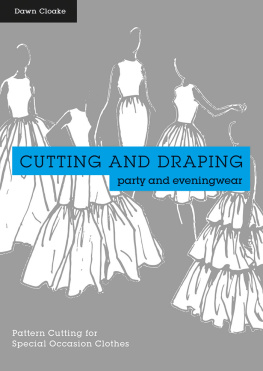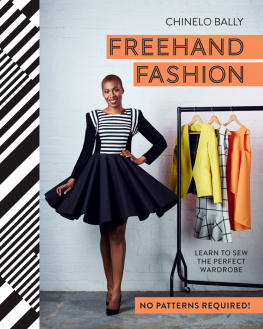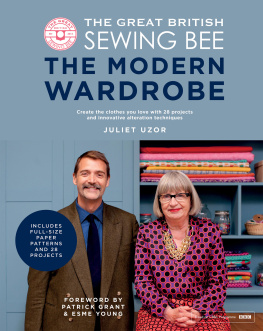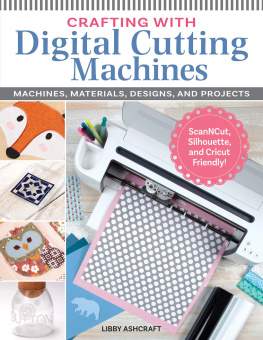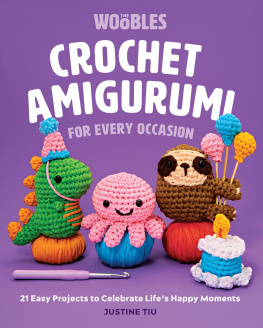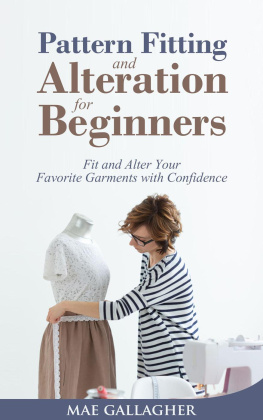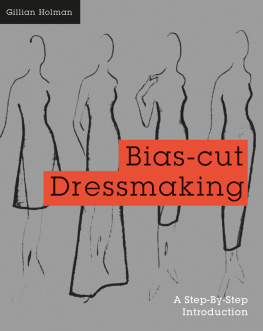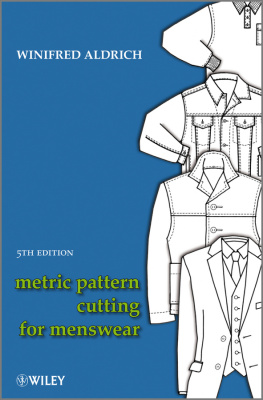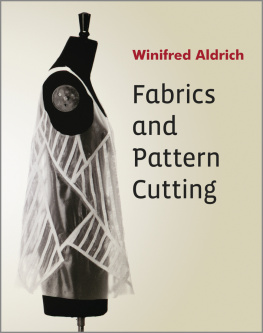

CONTENTS
INTRODUCTION
Cutting and Draping Party and Eveningwear concentrates on the construction of blocks and patterns for very close-fitting bodices and other dramatic style features found in evening and partywear. Instructions cover developing basic blocks into dress and jacket blocks and also into blocks for stretch fabrics; styles include strapless and draped bodices, low necklines, tight-fitting sleeves, fishtail skirts and godets, Princess- and Empire-line dresses, bustiers with and without sleeves, halter and cowl neck bodices, wrapover skirts and trousers with shaped and raised waistlines.
The book begins with a summary of dart manipulation, showing how to achieve curved and angled darts by the pivoting method, and follows with a section on blocks (basic patterns), explaining how and why these basic blocks and commercial pattern shells need to be adjusted for many special occasion clothing designs.
The book need not be worked through chronologically, but should be dipped in to for the answers to specific problems.
Where a number of similar garment designs may be required (for instance, when working in a design room) a good investment would be to make starter blocks for advanced styles for permanent use. Bypassing the basic block in this way avoids pattern cutting decisions and extra construction stages, allowing you to work faster and more efficiently. Strapless bodices need overall adjustment to achieve a close fit which will keep them in place during wear; low, wide necklines need tightening to prevent gaping; sleeveless styles need a tightened front armhole, even for low underarm styles, and stretch fabrics require block adjustment to reduce considerably (and sometimes eliminate altogether) the tolerance allowed in basic blocks for normal body movement. These adjustments, instead of being made individually for each separate design, need be done once only, the alterations marked on the new block, and the tightened shape recorded as a new secondary block specifically for a certain type of garment.
Flat pattern cutting and draping on the stand are two quite different techniques, but they can be combined to great advantage in the design room. A frequent problem for pattern cutters is to know how to construct a pattern for a part of a garment which is obviously easier to do on the dress stand. The technique of outlining the draped section on the dress stand, whether it be a whole bodice or simply a part of one, and checking it against the partly completed paper pattern, is covered on . Ruched panels, bust shaping, cowl necklines and a draped party top are all demonstrated as part flat cut and part modelled designs.
The capsule wardrobe at the end of the book brings together the basic elements of a wardrobe for special occasions, mixing and matching classic garments in beautiful fabrics to cover a variety of occasions for day and evening.
One of the aims of this book is to dispel the belief that every design must be developed from the basic daywear block and to nurture the idea of having appropriate starter blocks to hand for specific styles. All the adjustments suggested for blocks can be applied to commercial patterns. In addition, by introducing small elements of draping into flat pattern cutting, I hope to stimulate interest in the art of modelling directly on the stand.
This book is intended for teachers and students at all levels from Foundation up to post graduate degree levels on design and manufacturing courses; up to A level in school; practising designers and pattern makers in the clothing industry, including those working in film and theatre, home dressmakers and designer dressmakers working from their own studios.
EQUIPMENT LIST
Pattern paper
Metre rule
Scissors: for cutting paper and card
Tape measure with both metric and imperial measures
Short ruler
Set square: essential for obtaining right angles on patterns and fabrics
Tracing wheel: for copying patterns and for transferring lines from modelled fabric
French curve: useful for drawing smooth neck and armhole lines and curved seams
Pencils: hard pencils are marked with an H and produce fine, clear lines for pattern making; soft pencils, marked HB, are best for drawing and marking fabric
Dress stand
Calico for making toiles
Shears for cutting fabric
Narrow black stay tape [maximum width 7mm]: for taping design lines on the stand
Small scissors: for snipping into seam allowances and trimming
Marking pen: a water soluble pen or soft pencil is useful for marking toiles
Pins: long, fine pins are available for modelling fine fabrics; lills, very short pins, are useful for taping design lines on the stand, sinking into the surface at an angle and easily removed by pulling the tape off the stand.
Pin cushion: strap to the wrist so you can use both hands to hold fabric in position on the stand during modelling
Weights: to hold down fabric, card or paper patterns and prevent their moving when being outlined
Stiletto or scriber: for puncturing small holes in card
Notcher: clips out a small, narrow rectangle [a notch] in fabric, blocks or patterns.
Notebook and file: for recording exercises
Needles and thread: for tacking up toiles
SET OF BASIC BLOCKS
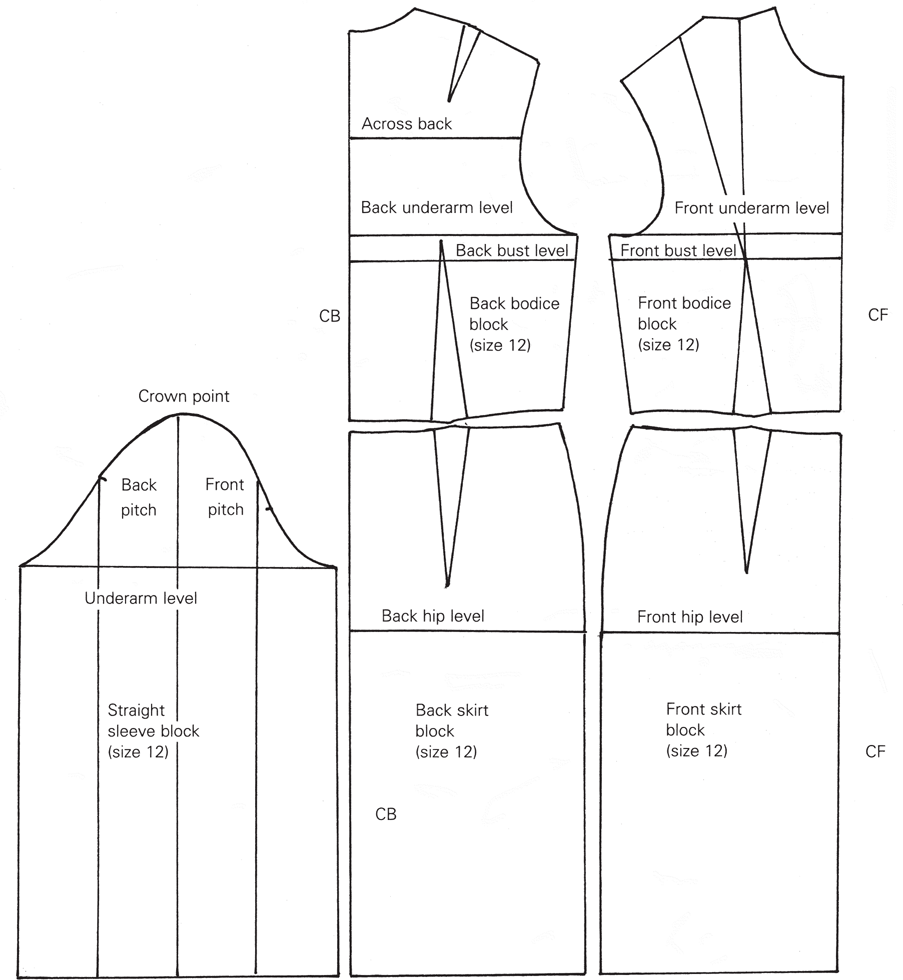
TAKING MEASUREMENTS
The following measurements represent body size, not block size. The figures shown in the movement tolerance column refer to the amounts already incorporated in the blocks to allow for normal body movement when wearing the garments. It is these amounts which will be changed when adapting the basic blocks to secondary blocks for developing close-fitting styles.


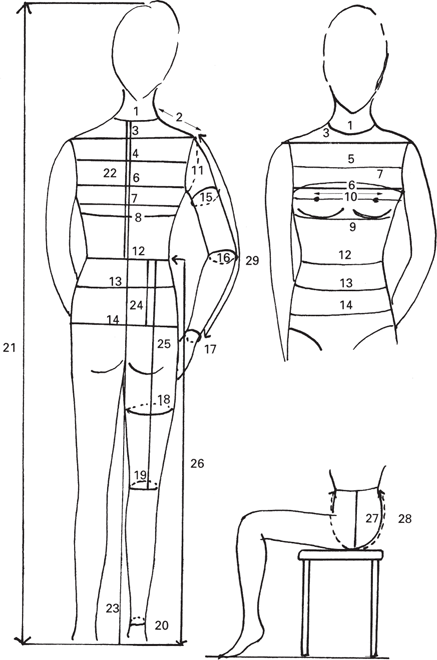
Neck girth
Shoulder length
Across shoulders
Across back
Across chest
Underarm level
Over bust girth
Bust level girth
Under bust girth
Bust separation
Armhole girth
Waistline
High hip line
Hip widest part
Bicep
Elbow
Wrist
Thigh
Knee
Ankle
Full height
Nape to back waist
Nape to ground
Waist to hip
Waist to knee
Waist to floor
Body rise
Crotch length
Outer sleeve
FABRICS
For all clothing, fabric is the essential ingredient. Deciding which fabric to use for special occasion clothes will mean considering the type of garment, when and where it will be worn, its structure the design lines and fit and the quality and characteristics of the desired fabric.
The dresses, long skirts, strapless bodices and bustiers in this book are mainly designed to be made in luxury fabrics. The jackets can be worn with skirts, trousers or dresses for both day and evening, the choice and quality of the fabric appropriate to the occasion.
Next page
